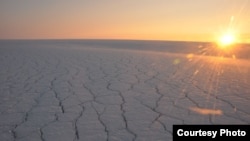Greenland is melting at record rates, and scientists want to know why.
“The Arctic is our alarm bell for climate science since it experiences climate change sooner, and more intensely,” said Kristof Van Tricht, a graduate student at the KU Leuven Department of Earth and Environmental Sciences in Belgium and lead author of a new study in the journal Nature Communications.
Van Tricht and his research team found that clouds play a bigger role than previously expected in accelerating the melt.
“Using satellite observations and ground instruments, we mapped clouds over the entire ice sheet,” he said.
Next the scientists performed the same simulations, under clear skies.
Clouds enhanced the melt runoff by one-third, compared with clear skies.
“Clouds have several effects,” Van Tricht explained. “On the one hand, they help add mass to the ice sheet when it snows. On the other, they have an indirect effect on the ice sheet. Clouds block the sunlight, which lowers the temperature, but at the same time, they form a blanket that keeps the surface warm, especially at night.”
A large part of the meltwater is stored in the upper levels of the snowpack, preventing it from draining into the ocean.
Under clear skies at night, the surface gets so cold that a large part of that meltwater refreezes. If it is a cloudy night, the surface is warmer and not as much meltwater can refreeze. Excess meltwater led to an extra 56 billion tons of runoff compared with a scenario without clouds.
Greenland is the planet's second-largest ice sheet, after Antarctica. Together they hold approximately 90 percent of the Earth's fresh water. Sea level could rise as much as six meters should Greenland completely disintegrate, putting world coastal communities at enormous risk.
“We need to try to understand as many aspects of the climate system as possible so we can do proper predictions,” Van Tricht said. “Our results are one new piece of the puzzle.”








